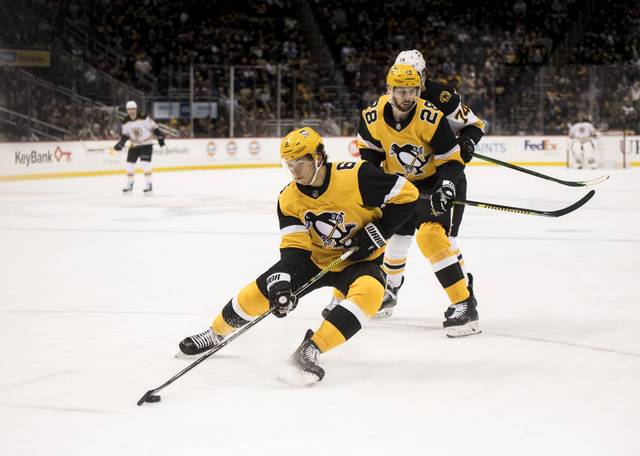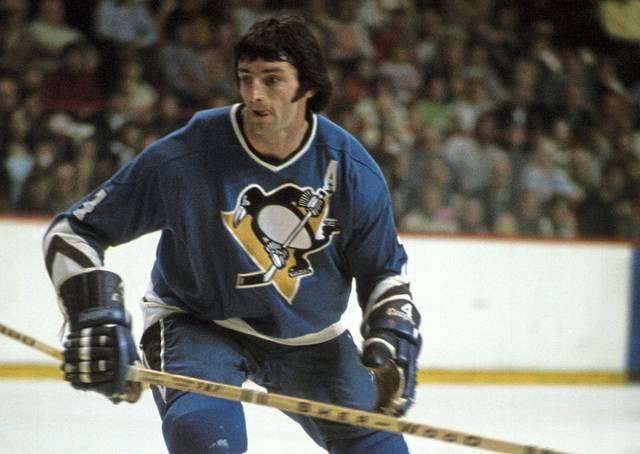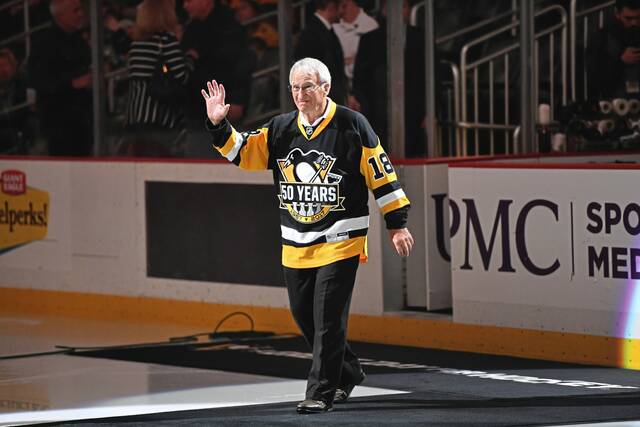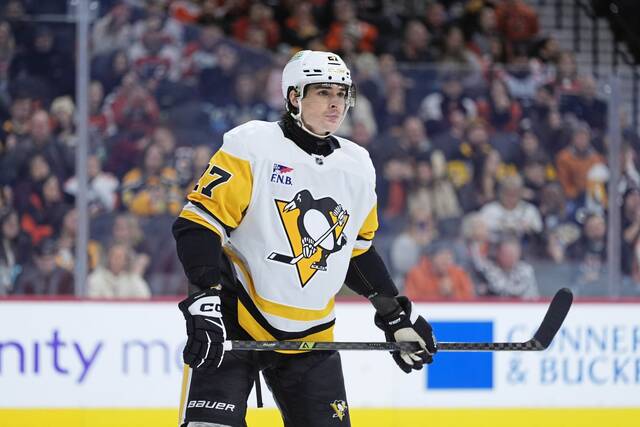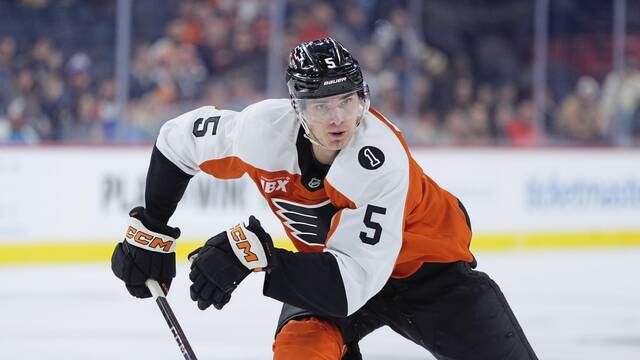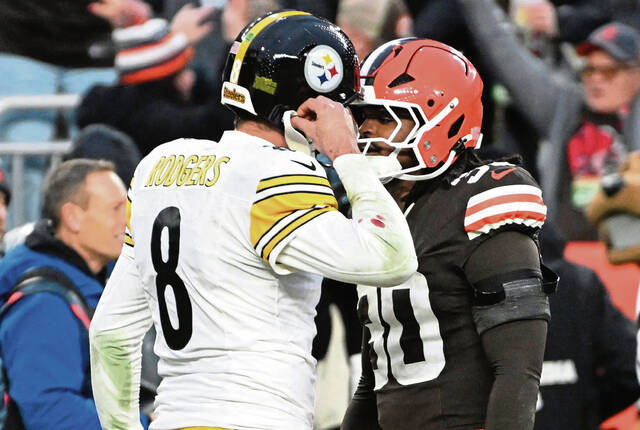John Marino’s timing is impeccable.
In one sense, he came along at just the right time for the Pittsburgh Penguins.
Saddled with a defense corps that sprung leaks during a mediocre 2018-19 season, especially in a first-round playoff exit, the team needed him.
Marino escaped the Edmonton prospect pool, built on a stellar Harvard career and recorded six goals, 26 points and a plus-17 rating before the season was put on pause. He handled the traditional pitfalls much better than the average rookie defenseman.
“What I was expecting was a much higher pace of play. Everyone is skilled. Everyone can contribute. Everyone can make a play,” Marino said. “Every game’s a battle, too. You can’t really take any games off. Not that you’re taking games off in college, but if you’re going into a game where you know your team should win the game, you probably take a step back.
“In the NHL, you can’t take a step back. Every shift, you have to compete and you have to be ready for. I think that was eye-opening, for sure.”
In another sense, Marino also came along at the right time in NHL history.
For decades, teams were wary of giving first-year players important minutes on the blue line. They were afraid of fresh-faced kids in their early 20s getting abused in front of the net by grizzled, bearded grown men.
A couple of examples from post-1997, when the league started keeping ice time records: Andrew Ference was a highly touted youngster in 1999, but he was limited to 16 minutes, 19 seconds per game. Kris Letang, a minutes muncher on defense if there ever was one, was afforded 17:30 as a rookie in 2007.
Marino, meanwhile, is averaging 20:15 this season. The Penguins have trusted him, more or less, from the word go.
“In the beginning, I was a little more sheltered, but they gained a little more trust with me the more they put me out there,” Marino said. “I think I was able to take advantage of the opportunity. It’s still definitely a learning process. I have a lot of stuff to figure out. I think the biggest thing is the coaching staff put their trust in me and being able to take advantage of an opportunity.”
When Marino’s rookie season concludes — if it hasn’t already — it will rank among the best for a first-year Penguins defenseman. In the meantime, beat writer Seth Rorabaugh and former beat writer Jonathan Bombulie compiled a list of the top five rookie defensemen in franchise history.
(Note: For the sake of argument, Marino has been omitted from these listings as his rookie season is not yet complete.)
BOMBULIE’S TOP 5
1. Zarley Zalapski, 1988-89
Joining the Penguins as they were starting to become contenders, Zalapski set franchise rookie defenseman records with 15 goals and 56 points that might never be broken. His numbers lose a little luster when adjusted for era. Teammate Paul Coffey, for instance, had 113 points that year.
2. Olli Maatta, 2013-14
It’s probably a misconception that Maatta’s first year was, by far, his best. Nine goals and 29 points was great, but he was a plus-27 in 2015-16 and had 29 points again in 2017-18. It is fair to say, though, that a 19-year-old Maatta, physically unscathed by the rigors of illness and NHL hockey, was a treat to watch.
3. Ryan Whitney, 2005-06
A cynic would suggest that Whitney was one of the first players to realize the value of hitching his wagon to Sidney Crosby. It helped him to six goals and 38 points as a rookie. In fairness, before his foot betrayed him, Whitney was a dynamic player with high-end offensive instincts.
4. Jim Johnson, 1985-86
Undrafted out of Minnesota-Duluth, Johnson had three goals and 29 points. He was a plus-12 for a team, in Mario Lemieux’s second year, that wasn’t very good. He fought Rick Tocchet and Wendel Clark. He was the only player on the team to appear in all 80 games.
5. Marty McSorley, 1983-84
First of all, what a fight card. Chris Nilan, Dave Brown, Behn Wilson, even Mark Messier twice. Second of all, he had nine points and a minus-39 rating. Without all those minuses, do the Penguins have the worst record in the league and get Mario Lemieux in the draft? Think about it.
RORABAUGH’S TOP 5
1. Zarley Zalapski, 1988-89
The standard-bearer for freshmen blue liners in Pittsburgh, Zalapski was tailor-made for the Penguins and their aggressive approach to the 1988-89 season as he put up 45 points (12 goals, 33 assists) in 58 games. Wearing No. 33, Zalapski was a vital component of the Penguins’ voracious “Double Trouble” power-play unit which included others who wore double-digit jerseys such as Mario Lemieux (No. 66) and Paul Coffey (No. 77). Zalapski’s offensive acumen helped the franchise reach the postseason for the first time in seven years. In 11 playoff games, he netted nine points (one goal, eight assists).
2. Olli Maatta, 2013-14
Once upon a time, Olli Maatta was a universally beloved precocious rookie who no one wanted to trade. That was in 2013-14 when a 19-year-old Maatta’s steady style allowed him to claim a regular spot on a roster filled with veteran blue liners who already had coach Dan Bylsma’s trust. The former first-round pick put up nine goals and 29 points – still career highs – in 78 games that season and helped the franchise make its eighth consecutive postseason appearance.
3. Dave Burrows, 1971-72
Arguably the greatest defensive player in franchise history, Burrows’ abilities are difficult to quantify because he played in an era where advanced metrics were light years away from being a concept while even basic numbers such as blocked shots weren’t maintained regularly. What is clear is, as a 23-year-old rookie in 1971-72, he played in 77 of a possible 78 games and put up 12 points (two goals, 10 assists) and accrued countless bumps and bruises through a hardscrabble style of play, presumably, while helping the franchise reach the postseason for only the second time. Finishing in fourth place for the Calder Memorial Trophy voting, his apprenticeship that season under partner Tim Horton and coach Red Kelly, two of the greatest defensemen in NHL history, helped craft Burrows into an all-star later in his career.
4. Paul Stanton, 1990-91
The 1990-91 season is a memorable one for the Penguins for a variety of reasons. Stanton’s rookie campaign is hardly one of them. But as a 23-year-old, Stanton found himself in the lineup for 75 of a possible 80 games and remained a steadying presence throughout the campaign while general manager Craig Patrick restructured the blue line by shipping out veterans such as Zalapski and Jim Johnson and replacing them with the likes of Larry Murphy and Peter Taglianetti. Putting up 23 points (five goals, 18 assists) that season, Stanton helped the franchise win its first Stanley Cup title.
5. Marcus Pettersson, 2018-19
His rookie season of 2018-19 should probably come with a qualifier as he spent the first two months with the Anaheim Ducks before landing in Pittsburgh via trade as 22-year-old. A scheduling quirk with that trade allowed him to play a league-high 84 games (teams play 82 games in normal seasons) and he put up 25 points (two goals, 23 assists). Blessed with a lengthy 6-foot-3 frame, Pettersson offered stability to the Penguins’ blue line last season and was arguably one of their more reliable players – admittedly, there were few candidates for this designation – during a brief four-game postseason run.
Seth Rorabaugh is a Tribune-Review staff writer. You can contact Seth by email at srorabaugh@tribweb.com or via Twitter @sethrorabaugh. Jonathan Bombulie is assistant sports editor. You can contact Jonathan at jbombulie@triblive.com or via Twitter @BombulieTrib.


